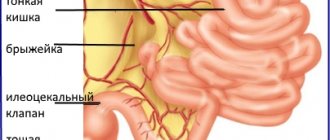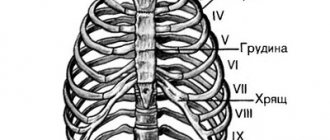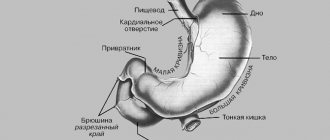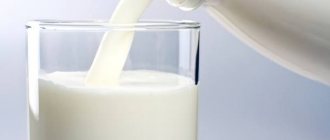(1) fundus of the stomach, (2) greater curvature, (3) body, (4) lower pole of the stomach, (5) pyloric (pyloric) part, (6) pyloric orifice, (7) angular notch, (8) lesser curvature , (9) folds of the mucous membrane
Stomach
(Latin
ventriculus
, Greek gaster) - a hollow muscular organ, part of the digestive tract, lies between the esophagus and the duodenum.
The volume of an empty stomach is about 0.5 liters. After eating, it usually stretches to 1 liter, but can increase to 4 liters.
The size of the stomach varies depending on the body type and degree of filling. A moderately full stomach has a length of 24-26 cm, the greatest distance between the greater and lesser curvature does not exceed 10-12 cm, and the anterior and posterior surfaces are separated from each other by approximately 8-9 cm. An empty stomach has a length of 18-20 cm, and the distance between the greater and lesser curvature is 7-8 cm, the back and front walls are in contact.
Is it true that reducing food consumption leads to a contraction of the stomach and, as a result, a person wants to eat less?
- No, the size of an adult’s stomach does not change; it can only be reduced surgically. But, despite this, with less food consumption, a person’s appetite regulator actually “reconfigures” over time; satiety arises from less food eaten.
An important feature of the stomach is its elasticity. The average volume is only 500 ml, however, this figure can easily increase up to eight times during a large meal. In general, the human stomach varies in size depending on body composition and type of diet. On average, in an adult, the length of the stomach does not exceed 26 cm, the width between the walls is 8-12 cm in normal condition. If a person’s stomach contains nothing, its volume is reduced by 1-3 cm.
It is generally accepted that the stomach is responsible for digesting food, but in practice this is not entirely true. Its main purpose is to grind food to a mushy state, which occurs with the help of wave-like contractions of the muscle fibers that make up the walls of this organ. In this case, the acid released into the stomach cavity during digestion promotes the breakdown and partial digestion of substances. The mucous membrane of the stomach walls also contains special elements that directly affect the process of hematopoiesis.
Location and structure of the stomach
Where is the stomach: schematic illustration
The stomach is located in the upper part of the abdominal cavity, directly below the diaphragm, most of it is located to the left of the spinal column. 3/4 of the size of the stomach is located in the left hypochondrium, 1/4 - in the epigastrium - this is the name of the abdominal area located under the sternum. Accurate localization of pain is very important for correct medical diagnosis.
The upper part of the stomach is located at the level of the 11th vertebra, it is called the cardiac part. Food enters it from the esophagus through the cardiac opening. To the left of the cardiac part of the stomach there is a fornix that passes into the body of the organ. The more convex edge is called the greater curvature, and the opposite concave edge is called the lesser curvature.
The lower section of the stomach is called the pyloric: it is divided into a wider section - the cave and the pyloric canal, through which food enters the duodenum. The pylorus contains a circular muscle - the sphincter and the valve; they prevent the contents of the digestive tract from reentering the stomach.
In Latin, the pylorus is called pylorus, so this part of the stomach is also called prepyloric. The cave is called the antral region of the stomach: it produces biologically active substances that stimulate the digestion process and control the functioning of cells that produce enzymes. It is also important to consider the structure of the walls of the stomach: on the outside, the organ is surrounded by a serous membrane, which contains connective tissue and mesothelium.
Read: How to reduce the size of your stomach in different ways
The middle layer contains several layers of muscle, providing the ability to increase size and contract. The inner layer consists of the mucosa and submucosa, the first of which has numerous folds on the surface. The mucous membrane contains numerous glands that produce hydrochloric acid and digestive enzymes.
The stomach in the abdominal cavity is placed in such a way that it is adjacent to the walls of other internal organs. The superior inlet and gastric fornix are adjacent to the diaphragm, and the fornix also touches the spleen. The lesser curvature of the stomach is adjacent to the liver, the greater curvature is adjacent to the large intestine. A small area is in contact with the anterior abdominal wall.
Anatomical and physiological characteristics (APF) in children and the elderly
In the fourth week of pregnancy, the embryo begins to form the pharynx, esophagus, stomach and partially other digestive organs from the foregut. In newborns, the stomach is located horizontally. When the baby gets on his feet and begins to walk, the axis moves to a vertical position.
The volume of physiological capacity does not immediately correspond to the size of the organ:
- in a newborn it is only 7 ml;
- on the fifth day - 50 ml;
- for the tenth - 80 ml.
In the neonatal period, the cardia and fundus are the most poorly developed. The cardiac sphincter does not function sufficiently compared to the pyloric sphincter, so the baby often burps. There are still few secretory glands in the mucous membrane; functionally it is ready to receive only mother's milk. Gastric juice has the same composition as that of an adult, but its acidity and enzyme activity are much lower.
The baby's stomach produces the main enzymes:
- chymosin (rennet enzyme) - necessary for the digestion and curdling of milk;
- lipase - for the breakdown of fats, but it is still small.
Peristalsis of the muscle layer is slowed down. The time it takes for food to be evacuated into the intestines depends on the type of feeding: in artificial babies it is delayed for a longer period. The development of the total mass of the gastric glands is influenced by the transition to complementary feeding and further expansion of nutrition. By adolescence, the number of glands increases a thousand times. In old age, the position of the stomach returns to horizontal again, and prolapse often occurs.
Sizes are decreasing. The muscle layer gradually atrophies and loses tone. Therefore, peristalsis is sharply slowed down, food is delayed for a long time. At the same time, the cells of the mucous membrane become depleted and atrophy, and the number of secreting glands decreases. This is expressed in a decrease in the production of pepsin, mucus, and a decrease in acidity. In elderly people, due to a pronounced atherosclerotic process in the mesenteric arteries, the nutrition of the organ wall is impaired, which provokes the formation of ulcers.
Functions of the stomach in the human body
The stomach performs complex functions
Food enters the stomach cavity in crushed form, and it is also mixed with saliva and mucus produced in the mouth. It stays in this section of the digestive tract for 3-10 hours, and during this time it is subjected to temperature treatment and chemical exposure. The stomach in the human body performs several functions:
- Secretory function. During the digestion process, the glands produce hydrochloric acid and enzymes, which allow food to be broken down into smaller compounds and prepared for subsequent absorption.
- Motor function. Thanks to muscle contractions, food is mixed and moved to the next section of the digestive tract - the duodenum.
- Suction function. With the help of the stomach, the human body absorbs water, sugar and salt, as well as some other substances.
- Protective. During the digestion process, hydrochloric acid and enzymes neutralize bacteria that enter the body with poor-quality food. This helps prevent poisoning and other negative consequences.
Before eating, the volume of an empty human stomach is 500 ml; after a hearty lunch or dinner, it can double. With constant overeating, it can reach 4 liters in volume, which cannot but have a negative effect on other organs of the abdominal cavity.
Read: Anatomy: where is the human stomach located, what functions does it perform?
Because of this, it is recommended to eat in small portions; overeating is especially dangerous at night. During sleep, food is digested extremely slowly, and this can lead to serious health problems in the future.
Digestion
Digestion in the stomach can be divided into two classes: mechanical and chemical digestion. Mechanical digestion is nothing more than the physical division of a mass of food into smaller portions, while chemical digestion is the transformation of larger molecules into smaller molecules.
• Mechanical digestion occurs due to the mixing actions of the stomach walls. Its smooth muscles contract, causing portions of food to mix with gastric juice, which leads to the formation of a thick liquid - chyme.
• While the food is physically mixed with the gastric juice, the enzymes present in it chemically break down the large molecules into their smaller subunits. Gastric lipase breaks down triglyceride fats into fatty acids and diglycerides. Pepsin breaks down proteins into smaller amino acids. Chemical decomposition, begun in the stomach, is not completed until the chyme enters the intestines.
But the functions of the human stomach are not limited to digestion.
Possible causes of gastric displacement
Structure of the stomach: schematically
In some cases, the stomach may change its location; even a slight displacement may indicate a serious pathology. Most often it occurs against the background of diseases of other internal organs; let’s look at the most common causes:
- Benign and malignant tumor formations. Stomach or duodenal cancer remains one of the most common and very dangerous forms, so at the slightest suspicion it is necessary to undergo a full examination.
- Perigastritis is an inflammatory process affecting the serous lining of the stomach. Its causes may be stomach ulcers, colitis, pancreatitis, and other inflammatory diseases of the digestive tract.
- Enlarged liver and spleen, affecting neighboring organs. The causes of liver enlargement can be hepatitis, impaired bile flow, cirrhosis, exposure to alcohol or drugs.
In all cases, treatment should be aimed at the underlying cause of the displacement of the stomach, it will allow the organs to return to their normal position. However, the stomach can change its location during pregnancy. During this period, due to the enlargement of the uterus, the stomach moves closer to the edge of the ribs, and because of this, its capacity is reduced.
A woman may feel an increased appetite, but if her stomach is full, she will feel serious pain. Because of this, during pregnancy it is especially important to eat small portions and avoid overeating. In addition, it is necessary to follow a daily routine to avoid unpleasant symptoms. After childbirth and the uterus shrinks in size, the organs will take their original position, and all negative symptoms will disappear without additional treatment.
What determines the functioning of the glands?
The causative agents for acid-forming parietal centers are protein foods, for example, meat. When consumed daily, increased acidity is maintained and the stomach works harder. High-carbohydrate foods have less effect on function. Carbohydrates help reduce acidity. But fatty foods are an intermediate option.
The active causative agent is stress, due to which an ulcer develops.
Therefore, if there is a long-term tense situation, it is recommended to eat more. No less strong feelings are melancholy, fear, depression, which, on the contrary, reduce gastric secretion. In this case, it is better not to eat these negative emotions with food, so as not to harm your health. But in case of prolonged depressive states, you should prefer meat as a snack, which will support digestive function.
Secretion processes in the stomach
If there is a disturbance in the functioning of the stomach, patients clearly indicate the location of the pain
Secretion is the process of releasing gastric juice necessary for digestion. It has an acidic, aggressive environment, so the body has a complex secretion regulation system that ensures the safety of the mucous membrane.
Read: Where is the human stomach: projections, anatomical landmarks
The mucous membrane does not begin to be digested under the influence of gastric juice, since its cells are constantly renewed, in addition, it is protected by a special layer of mucus. Good blood supply ensures normal functioning of the stomach, and the person does not feel any discomfort.
However, eating spicy, fatty, salty or too hot foods upsets the natural balance, which leads to gastritis and the gradual formation of ulcers. There are increased and decreased secretion. If there is excessive secretion of gastric juice, vomiting, a burning sensation, heartburn with pain and discomfort in the chest area may be observed. Hypersecretion can occur not only with overeating and unbalanced nutrition, but also with constant stress.
If a person is nervous while eating, the food may not be digested properly and over time, one may experience irritable stomach syndrome.
Increased secretion is diagnosed by gastric intubation with analysis of the environment. To normalize the functioning of the mucous membrane, patients are prescribed a special diet, and if the disorder has become very serious, drug treatment will be prescribed.
Reduced secretion can be observed against the background of nervous disorders, infectious diseases or functional disorders of the digestive system. It can be manifested by the appearance of belching, bloating, bloating and other unpleasant symptoms. The disorder is corrected with a special diet and medications; in addition, it is necessary to eliminate the root cause of disturbances in the gastrointestinal tract.
Knowing the location and principles of the stomach in the body, the patient can help the doctor make a diagnosis, as well as more consciously approach the prescribed treatment. The stomach is an amazingly complex multifunctional organ that plays one of the key roles in the digestive process.
Read along with this article:
- Anatomy: where is the human stomach located, what functions does it perform?
- What are the differences between the parts of the small intestine?
- Structure of the abdomen: abdominal organs and methods of examining the abdominal cavity
- Where is the human stomach: projections, anatomical landmarks
- All about digestion: what process occurs in the duodenum?
- Human small intestine: anatomy, functions and process...
- Digestive processes that occur in the small intestine
- Why does the size of an adult’s stomach vary from person to person?
- Small intestine: length and role in the digestive process










